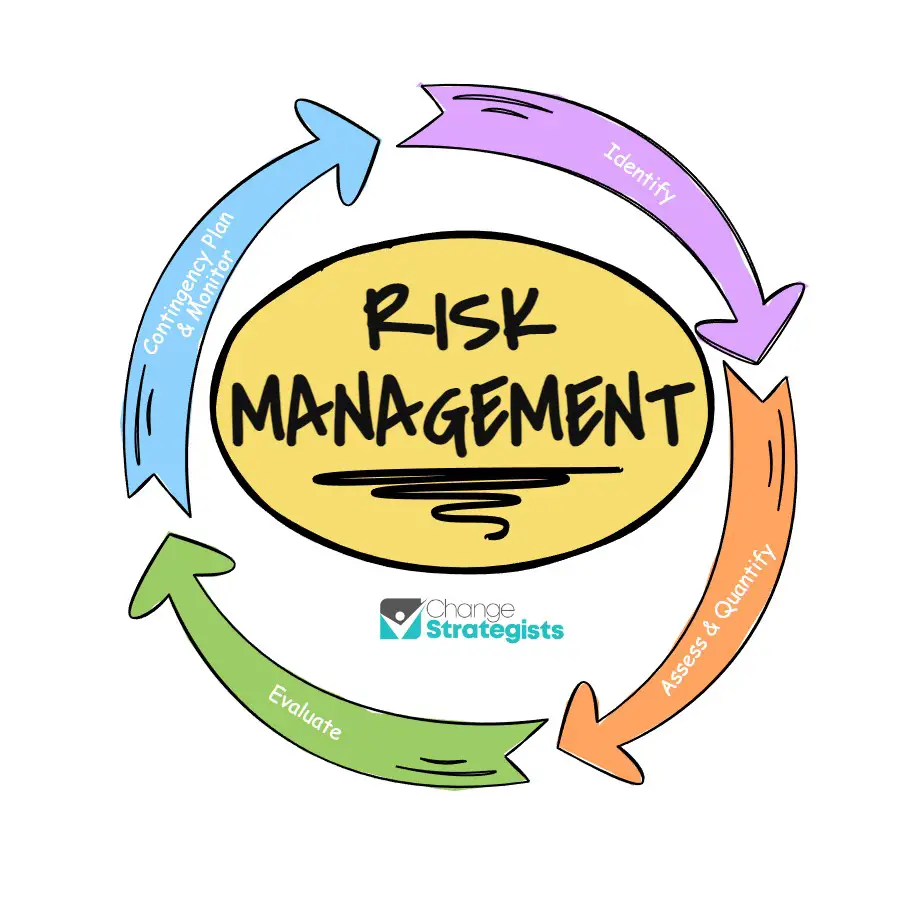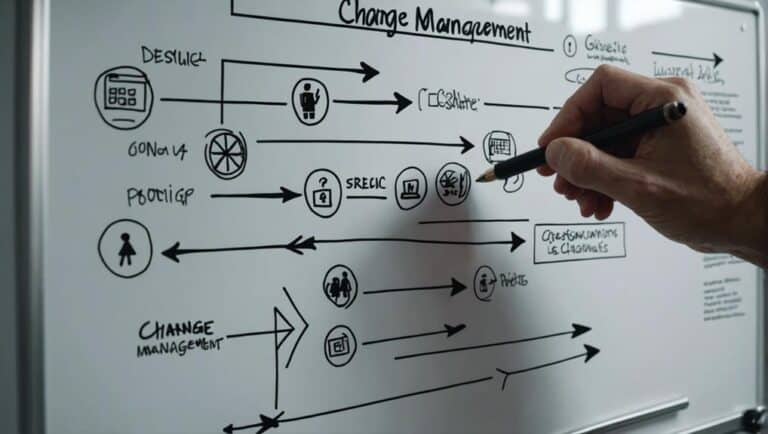Risks are a natural part of implementing change in an organization. Whether you’re trying to introduce a new technology or changing the way people do their work, there will be risks involved. So just how do you conduct a risk analysis when evaluating change requirements?
To conduct a risk analysis when evaluating change requirements, you must identify and quantify threats, establish a threshold, create a contingency plan, and monitor risks periodically. The risk analysis also determines whether a change should be implemented in an organization.
A risk analysis is a procedure used in business to assess the potential risks associated with making changes. The goal of a risk analysis is to identify and quantify the risks, prioritize them, and develop strategies to mitigate or reduce the risks.
Every organization goes through change at some point, and with change comes inherent risk. However, not changing at all is the biggest risk of all. The key to minimizing risks during a transition is appropriately analyzing the threat they pose and then managing it.
This article will help you learn how to perform a risk analysis to evaluate your change requirements and some other tips to minimize risks during the transition.
How To Conduct a Risk Analysis For Change
A risk analysis is an important tool that managers can use to evaluate potential changes within their company. By taking into account the possible risks and rewards of a change, managers can make informed decisions about whether to implement it.

When conducting a risk analysis, it is important to consider the potential impact of the change on all areas of the company. This includes financial, operational, and reputational risks.
The goal is to identify any risks that could potentially derail the success of the proposed change. To do this, managers should ask themselves three key questions:
1) What could go wrong?
2) What are the consequences if something does go wrong?
3) How likely is it that something will actually go wrong?
Once these questions have been answered, managers can then develop a plan to mitigate or eliminate any identified risks. By taking proactive steps to address potential problems before they occur, companies can increase their chances of successfully implementing changes without incident.
Identify Risks
Start by making a list of all the things that can potentially go wrong during the process. The goal isn’t just to think of the risks that may arise in the short term but also to determine the risks that may come as the change evolves.
When you brainstorm with your team to identify the potential risks, look beyond what’s obvious. Consider both internal and external potential threats you and your employees may find out of your control.
A good example is the potential resistance you can face from the stakeholders, which is almost always a risk involved in most change initiatives.
Quantify Risks
Once you’ve scoured through all possible threats, you need to calculate the associated risk probability. You need to calculate then how much it would cost you if the risk has a very high chance of occurring.
Use a scale of 1 to 5 for the possibility of the event occurring and the impact. Later, multiply them together to get a risk factor on a scale of 1 – 25.
Doing this will give you precise numbers and take the emotional and anxiety aspects out of the equation. You will no longer be making estimates in the dark and will have a clear picture of risks with the highest potential of becoming a reality.
Have a Threshold in Place
Determine a threshold of risk for your change initiative. The best practice is to start at the middle of the risk factor scale of 1-25. The threshold will fall at 12. Now, assess all the risks and see the ones that exceed the threshold. This will give you a clear idea of where to make adjustments to avoid exceeding the risk threshold.
Form a Contingency Plan
When you have all the possible risks identified, take some time to try and eliminate that risk by making minor adjustments. It is possible that some risks may get reduced to zero probability. Then, you need to think about the dangers as if they transform into actual events. How will the team respond in that scenario?
Planning will keep you prepared and prevent your initiative from being de-tracked.
Do Not Forget to Track
You will definitely use dashboards and software to keep track of the change management process. You must keep track of the risks you identified as well. You can use a chart or a log to map each risk’s risk factor and status.
As the project moves ahead, some risks will be marked off the chart because they’re no longer possible, or there will be others that pose even a greater threat than before.
This will help you mitigate any major risks before they thwart your entire project.
Assign a Point Person
Is there someone in your team that has a good eye for detail and is very good at documenting things and tracking progress? Then this person should be your risk watcher. Identifying and tracking risk progress should be part of their job description.
This person needs to be practical and proactively alarm you when they see a threat becoming a reality. They need to be able to put emotions aside and do their job, so the initiative is on track.

How to Manage Risk During Change
Risk analysis is an essential component of the entire change management process. It allows you to determine what can go wrong and how to manage things if something goes wrong.
So, how do you manage risk during a transition? Here are some tactics you can use to manage threats to your change initiative effectively:
Avoiding Risks
This strategy involves identifying and avoiding certain risks altogether. This could mean not embarking on a business venture or a merger that greatly threatens your business. When the costs associated with risk are too high and outweigh the benefits, you should pass on the initiative altogether.
Accepting Risks
When you do a cost and benefits analysis, some risks might be accepted because the benefits are far greater than the costs incurred. For example, you can accept the risk of a project getting delayed if the revenue generated after the launch will cover the costs.
If you have such risks in your list, you can look at the potential impact and create contingency plans to manage the impact better. It’s not necessary that all risks are bad and harmful; some have to be accepted at the cost of doing business.
Reducing Risks
There are some risks that cannot be avoided. However, you can reduce these through certain tactics. You can reduce the project’s scope or avoid a certain aspect of it to reduce the impact of the risk.
Sharing Risks
It’s a common practice in organizations to share the impact of the risk with other departments or third parties. They take the risk of the initiative upon themselves after determining that the organization has the ability to manage or avoid it. Insurance policies work on this principle of risk-sharing and transference.
4 Common Change Management Risks
As we mentioned before, no change initiative is free from risks. Risks come hand in hand with change initiatives. However, there are some common risks associated with every transition that you can prepare against in advance. Let’s look at these in detail:
Resistance
The most imminent of all threats. Resistance is part of every change initiative and is quite natural. People are comfortable doing things the usual way. People may also still remember failed change initiatives. To top it all off, if the initiative involves new technology or process automation, employees may feel the change threatens their job security.
All these factors contribute to teams and employees resisting change. See The Fear of Change: Why Is It So Hard For People And Companies To Accept Change?
Resistance has to be tactfully managed to ensure its impact is minimized. An effective communication strategy is required to make employees feel heard and reduce anxiety.
Managers must be transparent in communication and knowledge transfer to ensure employees have every resource possible to easily adopt change.
Lastly, in order to keep the change sustainable, managers must constantly reinforce the message and the change, so employees don’t go back to the old way of doing things.
Ill-Equipped Leadership
Leaders are a critical part of ensuring success during change management. Managers should have prior experience in leading teams through the initiative. They have to deal with the actual implementation and employee resistance at the same time. If that isn’t possible, you must invest in training these managers.
They should know how to manage teams and identify the root cause of risks before they materialize into full-blown problems that detract from the implementation of the change.
Operational Disruptions
These depend on the organization’s size and the project’s scale. Smaller changes may not result in significant disruptions. However, large-scale software deployments and process changes can disrupt even the simplest day-to-day business activities. This is a common risk associated with the implementation stage of the change process.
The key to minimizing these disruptions is handling the transition in small increments. In case of software updates, it’s best to schedule them for weekends and evenings instead of during a regular workday or timings.
You must also train employees to use the new software simultaneously.
Coercing Change
Employees, stakeholders, and managers should feel the need for change at every level. Only then can they become true advocates of change and adopt it without posing much resistance to the initiative. The biggest risk apart from resistance is forcing the change without the employees being on board with it.
The best way to do this is to constantly communicate the need for change. Find every opportunity and channel to help people realize how important and beneficial the change is for them and the organization.
Benefits of Active Risk Analysis and Management
Improved Planning
Data is at the heart of everything. What if you’re implementing new process automation, and it involves valuable customer data with a high risk of getting leaked? A proper risk analysis will ensure you know the sensitivity of the situation beforehand and have a contingency plan in place.
So, if the risk materializes as a true event, your customers and employees will thank you, and your business reputation will stay intact.
Loss Prevention
This one is in conjunction with the above point. Companies that are known for having effective risk mitigation strategies in place have the trust of their customers. Companies that suffer due to improper risk management lose employees and customers both.
Not investing time in risk analysis and management can result in damages such as a data breach that can later lead to costly lawsuits as well.
Smoother Change Implementation
Change is a time of uncertainty, and many things are up in the air. A proper risk analysis and management strategy will put some of your anxieties at ease. Knowing what can go wrong and having a good plan to respond is a blessing in disguise.
You and your employees will have one less thing to worry about as you navigate through the actual implementation plan.
Enhanced Focus
Active risk management ensures that the teams remain focused on the end goal. When they know risks are being monitored in real-time and there are resources assigned to sounding the alarm when a risk becomes an imminent threat, they can focus on achieving their milestones.
Fewer Surprises
If there is one thing that leadership in an organization hates, it’s surprises. Suppose you spent days convincing the management to approve a change, but because you had poor risk analysis, you and the team are now in a snag, and the leadership isn’t too impressed about it.
Proper risk analysis lets you communicate potential risks to the management before implementation and gives them the authority to either reject or approve the change based on their assessment.
So, when something does go wrong, they will be well aware and prepared for it beforehand.
Frequently Asked Questions
What are risk levels in change?
A risk level scale determines the severity of the impact of risk during a transition. This is a 1 to 5 scale, with 1 being the lowest and 5 being the highest level of risk. A formula can be used to determine the risk factor level of a risk that we’ve mentioned above in the article.
What is business risk?
Any factor that thwarts the ability of a business to reach its financial goals is a business risk. Any factor that damages a company’s revenue or leads it to failure is a business risk.
What are the three levels of risk?
Risks can be categorized into three levels – high, medium, and low. The risk level is a product of the risk’s likelihood and impact and is calculated during the risk analysis stage.
How Can Risk Analysis Help Support the Case for Change?
Risk analysis can be a powerful tool in making a strong argument for change. By identifying potential obstacles and evaluating their impact, it provides tangible evidence to support the need for a new direction. By highlighting potential risks, it underscores the necessity of embracing change.
Final Thoughts
Risk analysis is a gift that keeps on giving. It’s a tool that change managers can use to minimize their losses and ensure the successful implementation of the change. A transition that goes ahead without this analysis has a higher chance of failing.
We hope you use the risk analysis process mentioned above to help streamline the adoption of the change in your organization.





